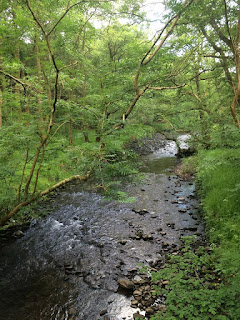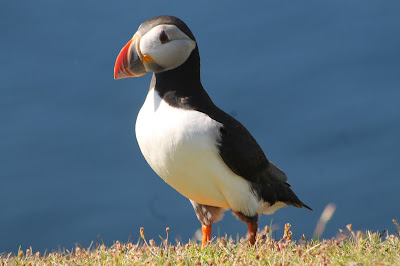I’ve always got a kick out of doing bird surveys. It’s great going out knowing that your records will become a tiny piece of the jigsaw that’ll help answer the puzzles of ornithology. Over the last six years I have had a lot of fun doing various surveys for the BTO including
Wetland Bird Survey (WeBS) counts,
Birdtrack,
BTO Garden BirdWatch and the Winter Thrushes Survey. However this year I decided to go further and take on possibly the BTO’s most challenging survey -
the Breeding Bird Survey.
The BTO’s Breeding Bird Survey (BBS) is the main scheme for monitoring the population changes of the UK’s common breeding birds. It involves two spring visits to a local Ordnance Survey 1-km square, to count all the birds you see or hear while walking along two 1-km lines across the square. These squares are randomly selected by the BTO and so, on a day around last Christmas, I sat down with my Dad to look at some which were on the list in Glamorgan. One particular square near Blackmill in the Ogwr Valley looked quite promising, with a nice variety of habitats and little disturbance. This was the square for me!
 |
River Ogwr on the first transect |
On a mild early March morning we checked out the site. Although it was just a reconnaissance visit, we also noted the different habitats present in the square – another essential part of the survey. The first kilometre transect seemed pretty promising for the season to come, with a small river nearby, some open lowland fields and a large old Oak woodland stretching along the path. Although just over 500m away, the second 1-km transect suggested we’d see a different selection of birds. Upland farmland was the dominant habitat here, although another Oak woodland at the end of the transect raised hopes of some decent woodland species too. I was very much looking forward to see what species I would get!
A month later on a quiet April morning, at a time when the majority of us teenagers are rarely awake, we left Cardiff and headed west. The day looked promising with good visibility, no rain and only a slight breeze.
At precisely 6:48 – you must note your start and finish time – we were ready to go. Our pace along the track also had to be taken into consideration: not too fast and not too slow. Each 1-km transect is split into 5 x 200m sections on your Field Recording Sheet with each 200m stretch expected to take 9-10 minutes. Although slower than my usual rambles, it gave me more of an opportunity to take everything in and to encounter more species. The adrenalin began to pick up as I jotted the first species of the morning; a singing Robin and 2 calling Coal Tit within 25m of the footpath. But as so many birds were singing, calling and flying around, the stress began to build up!
Over the next 45 minutes recording the birds had some sort of rhythm to it; a singing Mistle Thrush over 25 metres away, a Nuthatch calling nearby, 2 Ravens ‘cronking’ overhead, and….hello, a Pied Flycatcher?! Yes, a female, and good views too. I pencilled the letters ‘PF’ on the sheet with a lot of satisfaction. It was the wakeup call I needed at such an hour and I began to enjoy the morning more and more from then on.
The longer we walked the easier it seemed to get, especially since we were encountering the same species again and again and I grew in confidence in remembering the two-letter BTO code of every bird. Our first 1km produced some nice birds. Along with the Pied Flycatcher we recorded many singing Willow Warbler (WW), some Blackcaps (BC) and singles of Green (G.) and Great Spotted Woodpeckers (GS).
I certainly enjoyed the survey, but as we finished the first 1km stretch and walked back to the car to travel to the start point of the second 1-km transect, I was happy to be able to switch off for a few minutes. The concentration required for BBS is intense, there’s no denying it!
 |
| The ridge of Oak woodland at Blackmill |
We hopped into the car and after a 2 minute drive we clambered out and strode up the hill towards our second starting point. Before I knew it we were off again, and it was great to see some new species; Buzzard flying over distantly, Skylark singing above, a Linnet going over, calling.
About half way through our first transect we briefly saw another of the day’s specialities, a Redstart which flashed its rusty tail as it flew off. The fact we were on a hill (and most of the time in open country) meant we saw many more distant birds than in the first transect, and we saw more birds than we heard. The fields held many thrushes and Jackdaws that all went down on the Field Recording Sheet.
 |
| Wood Warbler by Allan Drewitt |
Before long we were walking under the canopy of the Oak woodland and we pricked our ears upwards. A Redstart and Willow Warbler was a good start, although nothing prepared us for what we heard next. Among the chorus of bird song the cascading notes of the Wood Warbler echoed through the wood. Get in there! Dad was beginning to get jealous he didn’t have this square for himself. Scribbling down this species gave me more pleasure than the Pied Fly. I’m quite lucky, I thought, to have this square. Wood Warbler, Pied Flycatcher and Redstart: Welsh birds at their best!
 |
| Exhausted but happy! |
Our final 2 x 200m sections were some of the best as we could still hear the woodland species to our right and also pick up farmland species to our left. Skylarks singing and, in the distance, a Red Kite was circling the area, making the day even more spectacular, another 2 singing Wood Warblers and some Swallows which were nesting in a nearby barn. As we walked further up the path I finally saw the finishing line – marked in yellow paint on the road by my father on our recce in March – which told me that I had at last completed my first BBS survey. Halleluiah! I don’t know if it’s the survey itself or my lazy teenage habits, but I was so tired that the road looked very comfy and all I wanted to do was to lie down on it, and that’s what I did! You can see the finishing line between my feet.
I very much enjoyed doing this survey. You don’t need to be an expert to take part, but you should be able to identify common birds by sight and sound and even though the high levels of concentration needed to do it properly are challenging, I can’t wait to go there again next year. In a few years I will be able appreciate it even more by comparing the birds recorded year after year and see how the wildlife will change over time. For me, there aren’t many things better than that!
Gethin Jenkins-Jones, Cardiff













